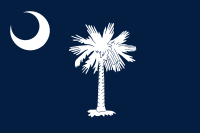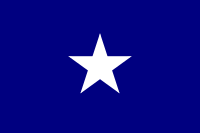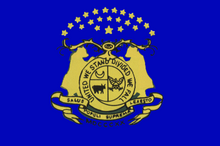Flags of the secessionist states
The secession movement in 1861 first brought about widespread use of national state flags. After the United States gained independence in 1776, most US states dropped the flags of the revolutionary movements and subsequently only used the Union flag. With the secession in 1861, almost all “ southern states ” adopted a national flag for the first time. Texas was the only state to already have a flag that came from the independence movement of 1835/1839.
South carolina
South Carolina was the first state to leave the United States and one of the first to adopt a new national flag. The design was based heavily on the revolutionary heritage: the crescent moon was the symbol of South Carolina in the times of colonial rule. The local troops wore it as a hat badge and used blue flags with the crescent moon in the Obereck.
The emblem of the palm tree also comes from revolutionary times. Its wood was allegedly used for the construction of " Fort Moultrie " and Charleston Harbor . Since palm wood is very flexible, it was not shattered under the fire of the British cannons, but absorbed much of the energy. This ability is believed to have contributed to the successful defense of Charleston on June 28, 1776. Shortly after this battle, the palm was adopted as the central symbol in the Great Seal of South Carolina.
Before the secession, many patriots already showed flags with a palm tree, which then became more and more widespread and could be seen in many different designs.
On January 26, 1861, South Carolina adopted an official flag that incorporated both of the major symbols of the state. The new flag consisted of the old revolutionary flag with a white crescent moon. Within an added white, oval field was the palm tree, which was shown in natural colors. Just two days later, on January 28, 1861, the design was changed to remove the oval and place the palm directly on the blue field. In this final variant, the flag still serves as the state flag of the state of South Carolina.
Mississippi
Mississippi was the second state to separate from the Union on January 9, 1861. As a sign of the new independence, the well-known " Bonnie Blue Flag " was hoisted in the capital Jackson . This flag was already used in 1810 by the so-called " Republic of West Florida ", which experienced a brief independence between September 16 and December 10, 1810. A song written in Mississippi in 1861 called "The Bonnie Blue Flag" became the second most popular patriotic song in the Confederation.
Mississippi adopted an official state flag on January 26, 1861. The "Bonnie Blue" flag was added as part of the upper corner. In the center was the representation of a magnolia tree in natural colors. Mississippi is still known today as the "magnolia state".
Florida
On January 10, 1861, Florida declared its withdrawal from the confederation.
It took Florida a long time to adopt a state flag, not least because it took a long time to agree on a design. In order to be able to show at least a provisional flag, a provisional flag was established by law of January 13, 1861. This was simply the flag of the United States, but with a single star in the upper corner.
It was not until September 13, 1861, that a new official state flag was set, which was modeled on the "Stars and Bars" flag of the Confederation . On the side of the flagpole, the new state coat of arms of Florida was inserted, which in natural colors showed a collection of weapons and flags under an oak tree. In the background of the coat of arms, ships lined the motto "In God is our trust".
Alabama
In anticipation of Alabama's secession from the Union, some ladies in Montgomery painted a flag to represent the newly independent state. The Legislative Assembly approved the proposal and the new flag was hoisted over the government building of the capital on January 11, 1861. The Alabama flag was unique within the "southern states" in that it had two different flag sides. On the front of the blue flag, the "Liberty" goddess was depicted in a red dress. She held a sword in her right hand and the Bonnie Blue flag in her left hand. The "Bonnie Blue" flag had a yellow border and a star of the same color. Above the star was the name "ALABAMA", also in yellow letters. In a large arch in the upper part of the flag was the motto: "Independent now and forever". The back of the cloth was also kept in blue. The picture showed a cotton plant, guarded by a rattlesnake, beneath which was the Latin motto: “Noli me tangere”, which means something like “don't touch me” in the sense of “leave me in peace”.
As attractive as this flag was, it was not easy to reproduce. The citizens of Alabama quickly used a simplified version, which consisted of the "Bonnie Blue" flag with a yellow star, which was also held by the goddess "Liberty".
The only official flag over the government building was badly damaged by a storm in late February 1861 and taken to the governor's office. The population of Alabama soon gathered more and more under the flag of the Confederate States of America.
Georgia
On the day of Georgia's declaration of independence on January 19, 1861, a new national flag was hoisted over the government building in Milledgeville . The flag was described as a white flag on which the state coat of arms of Georgia was applied. Traditionally, however, blue cloth was mostly used and the flag was probably carried that way as a military standard. However, a single surviving flag in a museum in Richmond shows the coat of arms on a red cloth.
The state flag of Georgia had a special meaning when Jefferson Davis was sworn in on February 18, 1861 as the first President of the Confederate States of America. Since no official Confederation flag had yet been adopted, an infantry company presented the flag of Georgia in the front row.
Louisiana
The pelican was probably a symbol of Louisiana for as long as this place existed. Since the beginning of the territorial status of Louisiana within the USA, he was its heraldic bird.
When Louisiana declared independence on January 26, 1861, a blue flag was presented with a white pelican in the center. This unofficial version of a first national flag was replaced by an official one on February 11, 1861. A flag was chosen that was very similar to the old Union flag of the United States. Like these, it had thirteen stripes. However, the color sequence was changed from red and white to blue, white and red, the colors of France, the cultural origin of Louisiana. In the upper corner, a single yellow star was placed on a red field. These in turn are the colors of Spain, which also controlled this area for a long time.
Texas
Texas has the richest vexillological heritage of any American state. After the secession on February 1, 1861, the Texan national flag was continued from January 25, 1839. This served Texas as an independent republic until 1845 and then as the state flag within the United States.
Virginia
When Lincoln's Secretary of War asked Virginia on April 15, 1861, to provide troops for the invasion of the Confederate States, this responded on April 17, 1861 by announcing independence and secession from the United States.
On April 30, 1861, a flag was adopted for the independent Commonwealth of Virginia. Virginia's flag consisted of the "Bonnie Blue" flag, in which the star was replaced by the Virginia's seal. This seal, which had already been adopted at the time of the revolution, contained a representation of the deity "Liberty", who slays an allegorical tyrant. Both the seal and the flag showed the Latin motto: Sic semper tyrannis , which means something like "This always happens to the tyrants". Virginia has this flag in a slightly modified form to this day.
Arkansas
Arkansas declared its exit from the Union on May 6, 1861 and became a member of the Confederate States of America on May 21, 1861. Arkansas did not adopt a separate state flag.
Tennessee
On April 25, 1861, the second extraordinary session of the Tennessee General Assembly met in Nashville . While the population was still against secession in February of the same year, the war continued unstoppably in April. Senate speaker Tazewell B. Newman proposed the creation of its own state flag that April day. The national flag of the Confederate States should be modified in such a way that the "Great Seal" of Tennessee is applied instead of the stars. However, since Tennessee was still a member of the United States at the time, it was thought unwise to make an obvious Confederate flag the state flag. When Tennessee practically left the Union on May 7, 1861, no law for its own state flag was passed. So it stayed with this flag proposal. Even so, the proposed state flag was used by at least two Tennessee infantry regiments in the war effort.
North Carolina
On May 20, 1861, exactly eighty-six years after North Carolina declared its desire for independence from Great Britain, the population gathered again and withdrew from the Union of the United States of America.
On June 22, 1861, North Carolina adopted a state flag reflecting both events. North Carolina also followed the "one star" principle, which was already reflected in the flags of Alabama, Florida, Louisiana, Mississippi and Texas. North Carolina took clear inspiration for the pattern from the Texas flag, but reversed the colors. The years May 20, 1775 and May 20, 1861 mark the declarations of independence from Great Britain and the USA, respectively.
Missouri
Missouri, which left the Union on October 31, 1861, did not adopt a separate state flag. However, on instructions from General Sterling Price , a flag was created for members of the so-called "Missouri State Guard" to fly. As early as the spring of 1861, General Price ordered that every regiment that was called to arms should be given its own "Missouri" flag. This consisted of blue cloth on which the state coat of arms in gold was affixed on both sides.
Kentucky
The last state to leave the old union was Kentucky. Although the state government was loyal to the United States, between November 18 and 20, 1861, a popular assembly of the citizens of Kentucky decided to declare independence from the Union. The state government was ousted and a provisional government was established, which practically divided the state. Under the auspices of the Provisional Government, Kentucky became a member of the Confederate States. An official state flag was not adopted, but the provisional government decided on January 16, 1862 to create a new state coat of arms. It is not known whether this national coat of arms was also applied to a flag with a blue cloth.
literature
- Devereaux D. Cannon, Jr .: The Flags of the Confederacy , St. Lukes Press, Memphis (USA), 1988, ISBN 0-918518-62-8

















